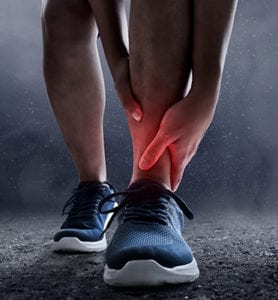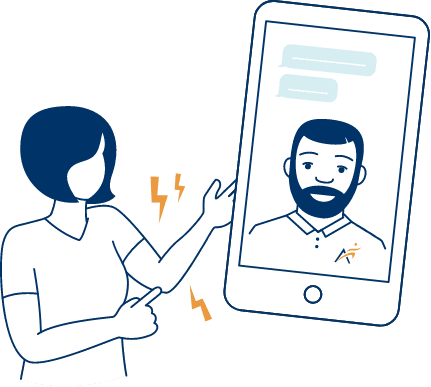(21,000+ reviews on Google across 150+ locations)
In this short video, Dr. Stephanie Niño gives a brief overview of the causes and symptoms of ankle sprains. She then walks you through four easy exercises to help with ankle mobility and foot stability. If you’re experiencing pain related to an ankle sprain, don’t hesitate to contact Airrosti. Our goal is to get you back on your feet and pain-free as quickly as possible. (Read our disclaimer here.)
Ankle sprains and strains are two often-confused injuries. These two injuries can cause pain and walking difficulty. Both terms are used to describe a tearing or an overstretching of the soft tissue surrounding your ankle joints and carry similar symptoms. Here are the key differentiators between the two:
Ankle sprains are the result of overstretching, or in some cases, tearing of the ankle ligaments. Ligaments connect the ankle bones together to create a joint and are made of tissue. Sprains are rather common in the ankles as the ankles are one of the most worked parts of the body.
As for symptoms, in a sprain, you will often see bruising surrounding the injured ankle joint.
Strains deal with a different part of the ankle. An ankle strain occurs when there is tearing or overstretching in the ankle’s tendons or muscles. Tendons are the glue that connects muscles to bones. They are composed of strong fibrous cords. When it comes to symptoms, ankle sprains set themselves apart because they often result in muscle spasms.

Strained or sprained ankles are very common injuries. They can happen when you take part in sports and other physical activities, but it can also happen when simply stepping on uneven surfaces or stepping down at an angle. Most people have experienced a twisted ankle at some point in their life. Pain and swelling are the most common signs that you have injured ankle ligaments in the case of a sprain and torn muscles/tendons in the case of a strain.
The ligaments, muscles, and tendons of the ankle hold the bones and joints in position. They protect the ankle joint from abnormal movements, especially twisting, turning, and rolling of the foot. When one of these parts of the ankle is forced to stretch beyond its normal range, a sprain or strain occurs. Sprains can occur on different parts of the ankle, and the most common ankle sprain occurs on the lateral, or outside, part of the ankle resulting in a lateral ankle sprain.
Some people are predisposed to ankle sprains and strains. For people with a hindfoot varus in which the general nature or posture of the heels is slightly turned toward the inside, these injuries are more common. This is because it is easier to roll/twist the ankle. For people who are predisposed to such injuries, it’s crucial to take measures of prevention.
In those who have had a severe sprain in the past, it is also easier to roll/twist the ankle and cause a new sprain or strain. Therefore, one of the risk factors of injuring the ankle is having ankle instability. Those who have weak muscles may be more predisposed. Risk factors also include activities, such as basketball and jumping sports, in which an individual can come down on and twist the ankle.

There are two types of ankle strains and sprains. Typically, the ankle is rolled either inward (inversion ankle sprain) or outward (eversion ankle sprain). Inversion sprains cause pain along the outer side of the ankle and are the most common type. Pain along the inner side of the ankle may represent more serious injuries to the ligaments or tendons and may need to be evaluated by a doctor.
Ankle sprains are often categorized into different grades depending on the severity of the sprain. These grades range from Grade 1 to Grade 3.
The ligaments have been stretched but have yet to tear. Symptoms will include mild swelling, pain, and joint instability/stiffness as well as issues jumping and walking.
The ligaments have partly torn. Symptoms will include difficulty walking, pain, bruising, considerable swelling, and loss of motion in the ankle.
The ligaments will be torn completely. This serious sprain will result in severe pain, swelling, and loss of motion, as well as joint instability and pain associated with walking.
As stated before, ankle sprains and strain symptoms are very similar and hard to distinguish. One of the telltale differentiating signs between the two is that ankle strains will often result in muscle spasms in the injured area, whereas ankle sprains will reveal a generous amount of bruising surrounding the inflicted area.
If a sprain or strain is not treated properly, long-term problems may occur. Sprains can be difficult to differentiate from fractures (broken bones) without an x-ray. If you are unable to bear weight after this type of injury, or if there is significant swelling or deformity, you should seek medical treatment from your primary care physician or a soft tissue specialist.
When a sprain occurs, blood vessels will leak fluid into the tissue that surrounds the joint. Along with inflammation, swelling from the fluid and ankle pain is experienced. The nerves in the area become more sensitive, so a throbbing pain is felt when pressure is placed on the area. Warmth and redness are also seen as blood flow is increased. Also present is a decreased range of motion, and difficulty using the affected leg.
Depending on the severity of the sprain, a person may or may not be able to put weight on the foot. If it’s a severe sprain, you might have felt a “pop” when the injury happened.
During the ankle sprain treatment and recovery period, patients are typically advised to avoid strenuous activity as there is a high occurrence of re-injury or the development of chronic problems.
Make sure to tell your doctor what you were doing when you sprained your ankle. Most ankle sprains do not require surgery, and mild sprains are best treated with a functional rehabilitation program. Depending on how many ligaments are injured, your sprain will be classified as Grade 1, 2, or 3.
The grade of the sprain dictates the treatment required, as well as the patient’s ability to bear weight on the ankle. Those patients who cannot bear weight are often prescribed a removable walking boot until they can comfortably do so. High ankle sprains take considerably longer to heal than other sprains.
Sprains and strains are common among the athletic community. Unfortunately, the lengthy recovery process typically associated with traditional treatment of these injuries often negatively impacts an entire season and significantly derails training progress. Traditional treatment for ankle injuries usually includes rest and several weeks of physical therapy to rebuild strength and range of motion.

There’s a variety of exercises you can do at home in addition to physical therapy. These exercises are designed to improve range of motion, ankle strength, and balance during the healing process. A few great ankle sprain exercises you can do at home are:
This stretch is great for exercising and strengthening your ankle and areas surrounding the ankle.
This dorsiflexion stretch is a great way to stretch your calves and improve ankle mobility.
This movement is a great way to build stability in the ankle.
If you’re an athlete who can’t afford to sit on the sidelines for several weeks, or if you’re just a fitness enthusiast who loves staying active and healthy, consider Airrosti. Our quality care approach helps rapidly speed recovery of your injury, and most patients are able to return to activity immediately (even while treatment is still in progress).
Remember that, even though ankle sprains are common, they are not always minor injuries. Some people with repeated or severe sprains can develop long-term joint pain and weakness. Treating a sprained ankle can help prevent ongoing ankle problems.
At Airrosti, we not only rapidly resolve the source of your injury, typically in as few as three visits (based on patient-reported outcomes), but we help prevent injury recurrence through education and a prescription for personalized at-home exercises.
Reviewed by Casey Crisp, Doctor of Chiropractic
Disclaimer: Always consult with your doctor before starting any exercise program. If you experience any numbness, tingling or reproduction of your symptoms, please contact your doctor.

I dealt with ankle/heel pain for a while, managing my pain with a brace and reduced activity. I went to Airrosti Alamo Ranch and found out it was a calf injury impacting the other areas of my leg, and Dr. Lakin and Anderson worked on my leg as such. After each visit, and individually using the exact instructions on my portal (icing, foam roller, taping, and exercises), I saw improvement each time I completed the day's requirements, and these exceeded my expectations. I only needed to attend three visits, and am fully equipped with exercises moving forward (to continue recovery and if pain arises again). The system really does work if it is properly utilized, and I am endlessly grateful to the chiropractic and physical therapy staff!
...+ show moreby Morgan Zachmeyer
